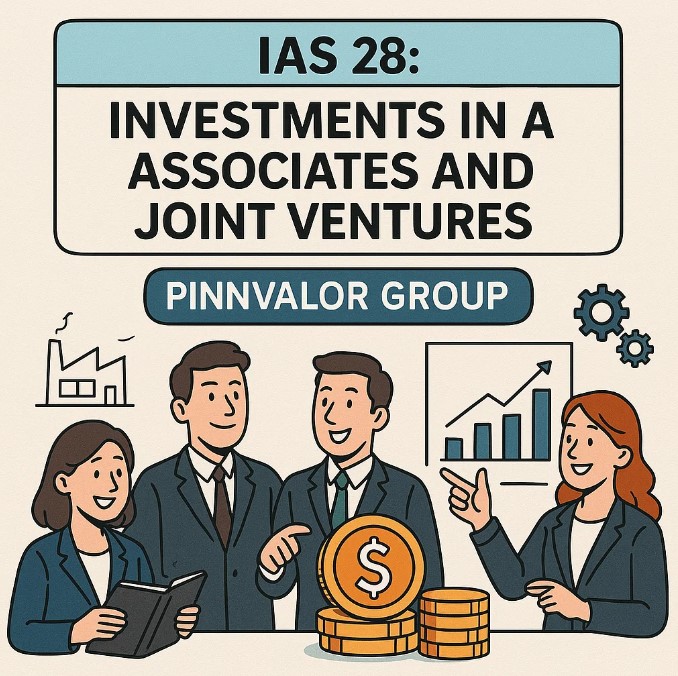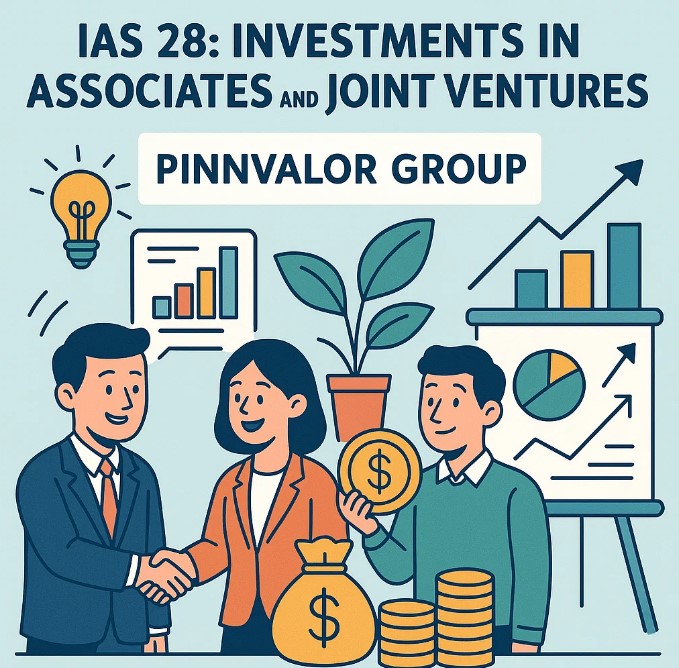
IAS 28: Investments in Associates and Joint Ventures – A Comprehensive Guide
In today’s interconnected world, businesses often invest in other entities to expand their reach, reduce risks, and gain strategic advantages. These investments may not always confer full control, but they may grant significant influence or involve joint control. IAS 28: Investments in Associates and Joint Ventures sets out the accounting framework for such investments under International Financial Reporting Standards (IFRS). This blog unpacks the standard’s key principles, scope, application, and real-world implications.
How do investors reflect their share in another company’s profits without owning it outright?
Through the equity method, investors don’t just track numbers—they tell the story of shared success, risks, and returns. It’s accounting that mirrors real-world relationships.
1. Objective of IAS 28
The objective of IAS 28 is to prescribe the accounting for investments in associates and joint ventures, and to set out the requirements for the application of the equity method when accounting for these investments.
2. Scope of IAS 28
IAS 28 applies to all entities that are investors with significant influence over an associate, or that have joint control over a joint venture.
It does not apply to:
- Investments in subsidiaries (covered by IFRS 10)
- Interests in joint operations (covered by IFRS 11)
- Investments measured at fair value through profit or loss in accordance with IFRS 9
3. Key Definitions
Associate:An associate is an entity over which the investor has significant influence, but not control or joint control.
Significant influence: The power to participate in the financial and operating policy decisions of the investee, without having control or joint control over those policies. Typically presumed when the investor holds 20% or more of the voting power.
Joint Venture:A joint venture is a joint arrangement whereby the parties that have joint control have rights to the net assets of the arrangement.
Equity Method:A method of accounting by which an investment is initially recognised at cost, and adjusted thereafter for the post-acquisition change in the investor’s share of the net assets of the investee.
4. The Equity Method – Step-by-Step
Initial Recognition:- The investment is recorded at cost, including transaction costs.
- Increase for investor’s share of profit or loss of the investee.
- Decrease for dividends received from the investee.
- Adjust for investor’s share of other comprehensive income of the investee.
- Adjust for investor’s share of other changes in equity (e.g., revaluation surplus).
- Assess for objective evidence of impairment.
- The investment is tested for impairment as a single asset.
- Losses are recognised until the carrying amount is reduced to zero.
- Further losses only if investor has legal/constructive obligation to fund losses.

5. Discontinuation of the Equity Method
The investor discontinues using the equity method when:
- It loses significant influence over an associate.
- It loses joint control over a joint venture.
At that point, the investment is measured at fair value, with any gain or loss recognised in profit or loss.
6. Practical Considerations and Challenges
- Complex Ownership Structures: Determining the existence of influence or control may be difficult.
- Upstream and Downstream Transactions: Eliminate profits to the extent of the investor’s interest.
- Reporting Timelines: Align reporting dates or adjust for material differences.
- Non-Uniform Accounting Policies: Adjust associate’s policies to match those of the investor, if practicable.
7. Interaction with Other Standards
- IFRS 10 – for subsidiaries where control exists.
- IFRS 11 – to classify joint arrangements.
- IFRS 9 – for financial instruments measured at fair value.
8. Illustrative Example
Scenario: Company A acquires 30% of Company B for $1 million.
- Company B earns profit of $200,000.
- Company B declares dividends of $50,000.
- Company A's share of profit: 30% of $200,000 = $60,000
- Dividend received: 30% of $50,000 = $15,000
Accounting Treatment:
- Initial investment: $1,000,000
- Add share of profit: +$60,000
- Less dividend received: –$15,000
Carrying amount = $1,045,000
9. Recent Developments and Amendments
Long-term Interests in Associates and Joint Ventures (Amendments to IAS 28):
Effective from 2019, these amendments clarified that long-term interests that form part of the net investment in an associate or joint venture are also subject to IFRS 9, including its impairment requirements.
10. Conclusion
IAS 28 is a vital standard in the IFRS framework, providing guidance on accounting for investments that fall between passive holdings and full control. By applying the equity method, investors present a more realistic view of their share in the performance and financial position of associates and joint ventures.
However, the standard requires careful judgment, especially in determining the nature of influence and in applying consistent policies across entities.
For preparers and analysts alike, understanding IAS 28 is key to evaluating the economic substance of strategic investments.
Tags: #IAS28 #IFRS #EquityMethod #Associates #JointVentures #FinancialReporting #AccountingStandards
